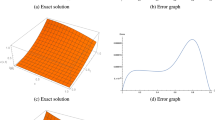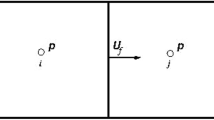Abstract
In this paper, a high-order compact difference scheme is proposed for solving multidimensional nonlinear Burgers’ equation. The three-stage third-order total variation diminishing (TVD) Runge–Kutta scheme is employed in time, and the three-point combined compact difference (CCD) scheme is used for spatial discretization. The proposed TVD-CCD method is free of using Hopf–Cole transformation, and treats the nonlinear term explicitly. Thus it is very efficient and easy to implement. Our method is effective to capture shock wave, third-order accurate in time, and sixth-order accurate in space. In addition, we show the unique solvability of the CCD system under non-periodic boundary conditions. Numerical experiments are given to demonstrate the high efficiency and accuracy of the proposed method.



Similar content being viewed by others
References
Bahadir AR (2003) A fully implicit finite-difference scheme for two-dimensional Burgers’ equations. Appl Math Comput 137:131–137
Bahadir AR, Saǧlam M (2005) A mixed finite difference and boundary element approach to one-dimensional Burgers’ equation. Appl Math Comput 160:663–673
Bateman H (1914) Some recent researches on the motion of fluids. Mon Weather Rev 43:163–170
Caldwell J, Wanless P, Cook AE (1981) A finite element approach to Burgers’ equation. Appl Math Model 5:189–193
Campos MD, Romão EC (2014) A high-order finite-difference scheme with a linearization technique for solving of three-dimensional Burgers’ equation. CMES-Comp Model Eng 103:139–154
Chen B, He D, Pan K (2018) A linearized high-order combined compact difference scheme for multi-dimensional coupled Burgers’ equations. Numer Math Theor Methods Appl 11:299–320
Chen B, He D, Pan K (2019) A CCD-ADI method for two-dimensional linear and nonlinear hyperbolic telegraph equations with variable coefficients. Int J Comput Math 96:992–1004
Chu P, Fan C (1998) A three-point combined compact difference scheme. J Comput Phys 140:370–399
Cole JD (1951) On a quasilinear parabolic equation occurring in aerodynamics. Quart Appl Math 9:225–236
Davidson GA (1975) A Burgers’ equation approach to finite amplitude acoustics in aerosol media. J Sound Vib 38:475–495
Dehghan M, Saray BN, Lakestani M (2014) Mixed finite difference and Galerkin methods for solving Burgers equations using interpolating scaling functions. Math Methods Appl Sci 37:894–912
Esipov SE (1995) Coupled Burgers’ equations: a model of poly-dispersive sedimentation. Phys Rev E 52:3711–3718
Fletcher CA (1983) Generating exact solutions of the two-dimensional Burgers’ equations. Int J Numer Methods Fluids 3:213–216
Gao G, Sun H (2015) Three-point combined compact difference schemes for time-fractional advection-diffusion equations with smooth solutions. J Comput Phys 298:520–538
Gao Q, Zou M (2017) An analytical solution for two and three dimensional nonlinear Burgers’ equation. Appl Mathods Model 45:255–270
Gottlieb S, Shu C (1998) Total variation diminishing Runger–Kutta schemes. Math Comput 221:73–85
Gülsu M (2006) A finite difference approach for solution of Burgers’ equation. Appl Math Comput 175:1245–1255
Gülsu M, Özis T (2005) Numerical solution of Burgers’ equation with restrictive Taylor approximations. Appl Math Comput 171:1192–1200
He D (2016) An unconditionally stable spatial sixth-order CCD-ADI method for the two-dimensional linear hyperbolic equation. Numer Algorithms 72:1103–1117
He D, Pan K (2017) An unconditionally stable linearized CCD-ADI method for generalized nonlinear Schrödinger equations with variable coefficients in two and three dimensions. Comput Math Appl 73:2360–2374
He D, Pan K (2018) A fifth-order combined compact difference scheme for the Stokes flow on polar geometries. E Asian J Appl Math 7:714–727
He D, Pan K (2018) An unconditionally stable linearized difference scheme for the fractional Ginzburg–Landau equation. Numer Algorithms 79:899–925
Hopf E (1950) The partial differential equation \(u_t+uu_x=\mu u_{xx}\). Commun Pure Appl Math 3:201–230
Huang P, Abduwali A (2010) The Modified Local Crank–Nicolson method for one- and two-dimensional Burgers’ equations. Comput Math Appl 59:2452–2463
Jiwari R (2012) Haar wavelet quasilinearization approach for numerical simulation of Burgers’ equation. Comput Phys Commun 183:2413–2423
Jiwari R (2015) A hybrid numerical scheme for the numerical solution of the Burgers’ equation. Comput Phys Commun 188:59–67
Khesin B, Misiolek G (2007) Shock waves for the Burgers equation and curvatures of diffeomorphism groups. Proc Steklov I Math 259:73–81
Kraenkel RA, Pereira JG, Manna MA (1992) Nonlinear surface-wave excitations in the Benard–Marangoni system. Phys Rev A 46:4786–4790
Kumar M, Pandit S (2014) A composite scheme for the numerical simulation of coupled Burgers’ equation. Comput Phys Commun 185:809–817
Kutluay S, Bahadir AR (1999) Numerical solution of one-dimensional Burgers’ equation: explicit and exact-explicit finite difference methods. J Comput Appl Math 103:251–261
Kutluay S, Ucar Y (2013) Numerical solutions of the coupled Burgers’ equation by the Galerkin quadratic B-spline finite element method. Math Methods Appl Sci 36:2403–2415
Lee S, Liu J, Sun H (2014) Combined compact difference scheme for linear second-order partial differential equations with mixed derivative. J Comput Appl Math 264:23–37
Lewis R, Nithiarasu P, Seetharamu K (2004) Fundamentals of the finite element method for heat and fluid flow. John Wiley & Sons
Li L, Sun H, Tam S (2015) A spatial sixth-order alternating direction implicit method for two-dimensional cubic nonlinear Schrödinger equations. Comput Phys Commun 187:38–48
Liao W (2008) An implicit fourth-order compact finite difference scheme for one-dimensional Burgers’ equation. Appl Math Comput 206:755–764
Liao W (2010) A fourth-order finite-difference method for solving the system of two-dimensional Burgers’ equations. Int J Numer Methods Fluid 64:565–590
Liao W, Zhu J (2011) Efficient and accurate finite difference schemes for solving one-dimensional Burgers’ equation. Int J Comput Math 88:2575–2590
Mahesh K (1998) A family of high order finite difference schemes with good spectral resolution. J Comput Phys 145:332–358
Mittal RC, Jiwari R (2012) A differential quadrature method for solving Burgers’-type equation. Int J Numer Methods Heat Fluids Flow 22:880–895
Pan K, Jin X, He D (2020) Pointwise error estimates of a linearized difference scheme for strongly coupled fractional Ginzburg-Landau equations. Math Methods Appl Sci 43:512–535
Sari M, Gürarslan G (2009) A sixth-order compact finite difference scheme to the numerical solutions of Burgers’ equation. Appl Math Comput 208:475–483
Sari M, Gurarslan G (2009) A sixth-order compact finite difference scheme to the numerical solutions of Burgers’ equation. Appl Math Comput 208:475–483
Shandarin SF (1997) Three dimensional Burgers’ equation as a model for the Large-scale structure Formation in the Universe. IMA 85:401–413
Shukl HS, Tamsir M et al (2016) Modified cubic B-spline differential quadrature method for numerical solution of three-dimensional coupled viscous Burgers’ equation. Mod Phys Lett B 30:1650110
Su NH, Watt PC et al (2004) Analysis of turbulent flow patterns of soil water under filed conditions using Burgers’ equation and porous suction-cup samplers. Aust J Soil Res 42:9–16
Sun H, Li L (2014) A CCD-ADI method for unsteady convection-diffusion equations. Comput Phys Commun 185:790–797
Tamsir M, Srivastava VK, Jiwari R (2016) An algorithm based on exponential modified cubic B-spline differential quadrature method for nonlinear Burgers’ equation. Appl Math Comput 290:111–124
Varöglu E, Finn WDL (1980) Space-time finite elements incorporating characteristics for the Burgers’ equation. Int J Numer Methods Eng 16:171–184
Wang QH, Pan KJ, Hu HL (2018) Unique solvability of the CCD scheme for convectionCdiffusion equations with variable convection coefficients. Adv Differ Equ 2018:163
Xie S, Li G et al (2010) A compact finite difference method for solving Burgers’ equation. Int J Numer Methods Fluids 62:747–764
Yadav OP, Jiwari R (2017) Finite element analysis and approximation of Burgers–Fisher equation. Numer Methods Part Differ Equ 33:1652–1677
Yang L, Pu X (2016) Derivation of the Burgers’ equation from the gas dynamics. Commun Math Sci 14:671–682
Yue X, Bu W et al (2018) Fully finite element adaptive AMG method for time-space Caputo–Riesz fractional diffusion equations. Adv Appl Math Mech 10:1103–1125
Yue X, Shu S et al (2019) Parallel-in-time multigrid for space-time finite element approximations of two-dimensional space-fractional diffusion equations. Comput Math Appl 78:3471–3484
Yue X, Liu M et al (2019) Space-time finite element adaptive AMG for multi-term time fractional advection diffusion equations. Math Methods Appl Sci. https://doi.org/10.1002/mma.5876
Zabusky NJ, Kruskal MD (1965) Interaction of solitons in a collisionless plasma and the recurrence of initial states. Phys Rev Lett 15:240–243
Zhu H, Shu H, Ding M (2010) Numerical solutions of two-dimensional Burgers’ equations by discrete Adomian decomposition method. Comput Math Appl 60:840–848
Acknowledgements
The author would like to thank the anonymous editor and reviewers for their constructive comments that improved the paper substantially. Kejia Pan was supported by Science Challenge Project (TZ2016002), the Natural Science Foundation of China (41874086), the Excellent Youth Foundation of Hunan Province of China (2018JJ1042) and the Innovation-Driven Project of Central South University (2018CX042). Xiaoqiang Yue was supported by the Natural Science Foundation of China (11601462, 11901189), Project of Scientific Research Fund of Hunan Provincial Science and Technology Department (2018WK4006) and Hunan Provincial Natural Science Foundation of China (2018JJ3494), Xiaoxin Wu was supported by Tian’an Cup College Students’ innovation and entrepreneurship training Project (TAB2019-01).
Author information
Authors and Affiliations
Corresponding author
Additional information
Communicated by Corina Giurgea.
Publisher's Note
Springer Nature remains neutral with regard to jurisdictional claims in published maps and institutional affiliations.
Appendices
Appendix A.
Appendix B. Matlab code for deriving (28)

Rights and permissions
About this article
Cite this article
Pan, K., Wu, X., Yue, X. et al. A spatial sixth-order CCD-TVD method for solving multidimensional coupled Burgers’ equation. Comp. Appl. Math. 39, 76 (2020). https://doi.org/10.1007/s40314-020-1063-6
Received:
Revised:
Accepted:
Published:
DOI: https://doi.org/10.1007/s40314-020-1063-6
Keywords
- Total variation diminishing
- Sixth-order accuracy
- Combined compact difference
- Burgers’ equation
- High efficiency




